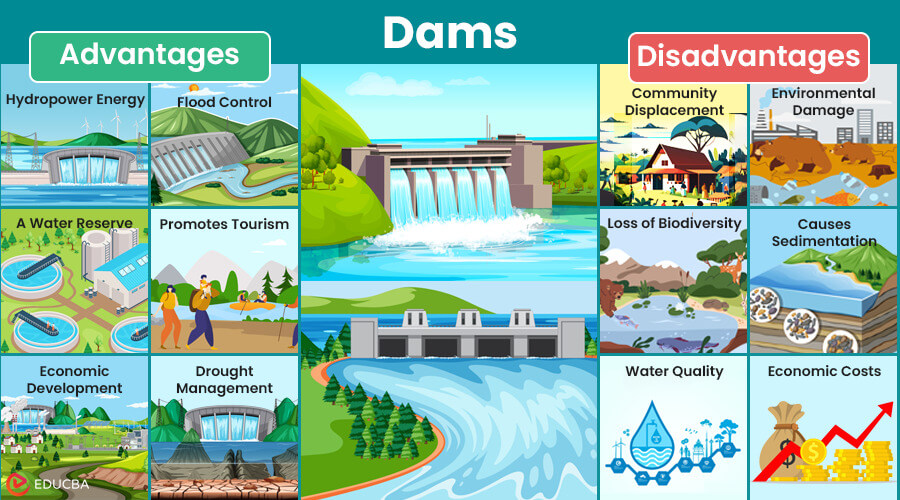
Advantages and Disadvantages of Dams – Overview
Did you know that the Chinese “Three Gorges Dam” is the largest dam worldwide? It can hold up to 39.3 billion cubic kilometers of water, which is approximately 39,300,000,000,000,000,000 buckets of water—quite mind-boggling, right? Such dams are undoubtedly beneficial for society as they provide a range of advantages. For example, the “Aswan High Dam” in Egypt has helped Egypt become self-sufficient in food production and exports.
However, it’s also essential to know the negative effects of dams. For example, while constructing Brazil’s “Belo Monte Dam,” over 500 square kilometers of land was cleared. It led to the relocation of around 20,000 indigenous people, deforestation, and loss of biodiversity.
It shows that there are both advantages and disadvantages of dams, and by examining them, we can comprehensively understand their impacts on ecosystems, communities, and economies.
Advantages of Dams
Let’s take a look at the advantages of dams:
1. Facilitates Hydropower Energy Generation
Dams allow us to convert the energy of flowing water into electricity through turbines. This form of energy production is renewable and highly efficient and helps generate large amounts of electricity consistently. This electricity powers lights, appliances, and machines at homes, businesses, and factories. And unlike coal or gas, hydropower doesn’t pollute the air.
2. Helps Prepare for Flood Control
Dams act like giant barriers across rivers. When heavy rains fill the rivers, they can hold back the extra water in reservoirs behind them. Then, they release water slowly and gradually over time to prevent flooding. It protects communities, infrastructure, and farmland but also reduces the need for costly disaster recovery efforts.
3. Acts as a Water Reserve
Reservoirs formed by dams serve as reliable sources of water for various needs, including drinking, irrigation, and industrial use. It stores water during rainy seasons and releases it during summer. Dams ensure a consistent supply, which is important for agriculture, urban development, and sustaining ecosystems.
4. Conserves Biodiversity & Promotes Tourism
Dams create lakes called reservoirs where people can fish, boat, swim, and watch wildlife. Allowing these activities can attract more tourists to the area. Moreover, these reservoirs also give homes to lots of different plants and animals.
5. Contributes to Economic Development
Dams provide water for farms to grow crops and factories to make products. They also produce electricity to power homes and businesses. Dams create jobs for people working on construction projects. Dams attract businesses and investments to the area, boosting the local economy.
6. Allows Drought Management
Dams store water during rainy seasons. The government can release the stored water during dry seasons to help farmers irrigate their crops, keep industries running, and ensure communities have enough water to drink.
Disadvantages of Dams
Let’s take a look at the disadvantages of dams:
1. Requires Community Displacement
Building a dam often involves creating a reservoir that requires relocating homes, farmland, and even entire villages. This displacement leads to the loss of livelihoods, disrupts social cohesion, and causes psychological stress for affected communities. Even if authorities provide compensation, it may not fully address the loss of homes, ancestral lands, and community ties.
2. Can Cause Environmental Damage
Dams change rivers’ natural flow, affecting ecosystems in various ways. Less water downstream (the direction in which the water flows) can harm habitats like wetlands and floodplains, which are home to many animals and plants. Also, the water behind dams can become warmer with less oxygen, harming aquatic life such as fish and amphibians.
3. Leads to Loss of Biodiversity
Building dams splits rivers, separating plants and animals. This separation decreases the genetic diversity in these populations. Fish, like salmon, who usually swim upstream to lay eggs, face challenges because of it. Dams also disrupt how nutrients move through the water and how food chains work, damaging the area’s variety of life.
4. Causes Sedimentation
Rivers usually carry dirt and rocks downstream as they flow, which helps keep soil healthy and riverbeds strong. But dams block this flow, so all the dirt and rocks pile up behind the dam instead. This can cause erosion and fertility issues downstream. Also, over time, all that buildup can fill up the reservoirs behind the dams, which means people might have to spend a lot of money to clean them out.
5. Impacts Water Quality
When dams create reservoirs, the water can become stagnant, meaning it gets stuck and doesn’t move much. This stagnation leads to the accumulation of pollutants, including heavy metals and agricultural chemicals. It makes the water unsafe for drinking and farming. Stagnant water also breeds mosquitoes, increasing disease risks for nearby communities.
6. Includes Economic Costs
Dams incur significant costs, including initial construction expenses, ongoing maintenance and repairs, environmental mitigation measures, and compensation for displaced communities. Moreover, the economic benefits of dams may not always materialize as expected, leading to financial losses for investors and taxpayers.
Final Thoughts
Acknowledging the advantages and disadvantages of the dams help us understand how dams bring valuable benefits like flood control and electricity but also pose challenges such as habitat disruption and community displacement. Balancing these factors is vital for Governments, industries, and local communities to collaborate for better water management.
Recommended Articles
If you found our article listing the advantages and disadvantages of dams helpful, please consider visiting the following recommendations.
